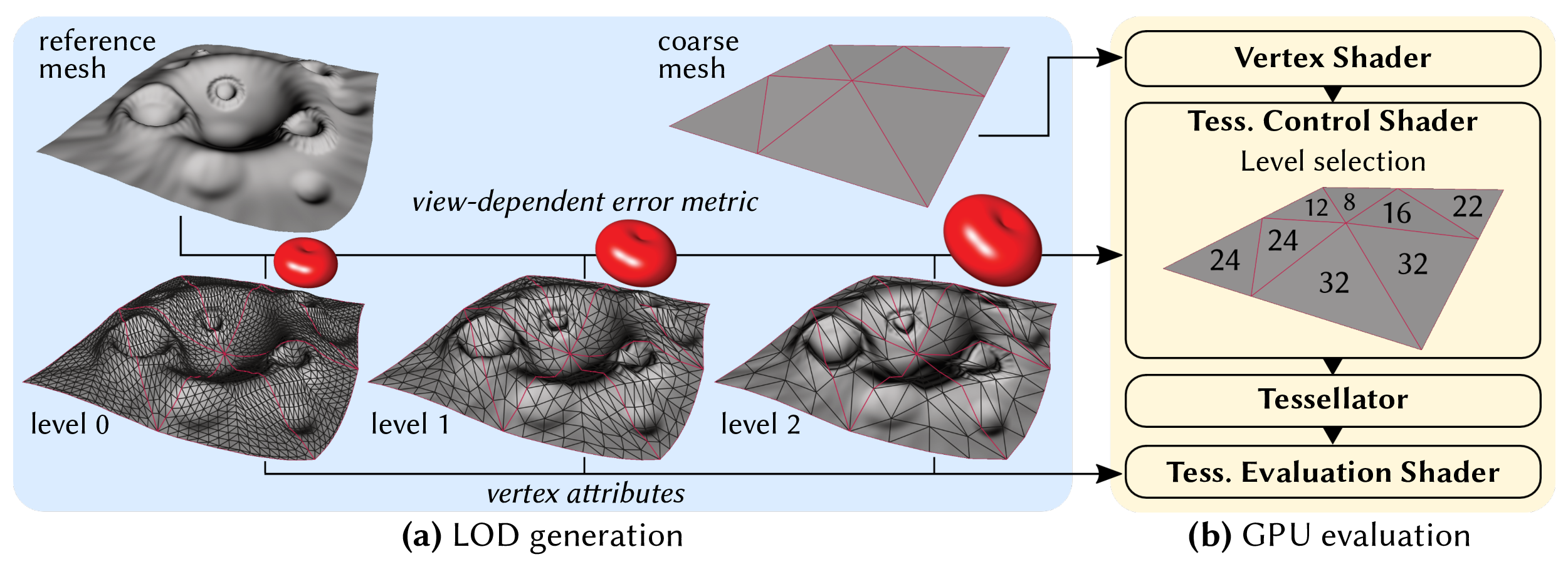Section:
New Results
Rendering, Visualization and Illustration
A View-Dependent Metric for Patch-Based LOD Generation & Selection [4]
Figure
8. Full processing pipeline — (a) as a pre-process, the LOD is generated from the reference mesh by decimation and, for each patch, at each level, its approximation error with respect to the reference surface is summarized into a compact view-dependent metric, (b) these are then used during hardware tessellation to select the most appropriate patch level according to the current viewing distance and direction.
|
|
With hardware tessellation, highly detailed geometric models are decomposed into patches whose tessellation factor can be specified dynamically and independently at render time to control polygon resolution. Yet, to achieve maximum efficiency, an appropriate factor needs to be selected for each patch according to its content (geometry and appearance) and the current viewpoint distance and orientation. We proposed [4] a novel patch-based error metric that addresses this problem (Fig. 8). It summarizes both the geometrical error and the texture parametrization deviation of a simplified patch compared to the corresponding detailed surface. This metric is compact and can be efficiently evaluated on the GPU along any view direction. Furthermore, based on this metric, we devise an easy-to-implement refitting optimization that further reduces the simplification error of any decimation algorithm, and propose a new placement strategy and cost function for edge-collapses to reach the best quality/performances trade-off.
MNPR: A Framework for Real-Time Expressive Non-Photorealistic Rendering of 3D Computer Graphics [12]
Figure
9. A 3D scene rendered through MNPR in watercolor, oil and charcoal styles. Baba Yaga’s hut model ©Inuciian.
|
|
We developed [12] a framework for expressive non-photorealistic rendering of 3D computer graphics: MNPR. Our work focuses on enabling stylization pipelines with a wide range of control, thereby covering the interaction spectrum with real-time feedback. In addition, we introduce control semantics that allow cross-stylistic art-direction, which is demonstrated through our implemented watercolor, oil and charcoal stylizations (Fig. 9). Our generalized control semantics and their style-specific mappings are designed to be extrapolated to other styles, by adhering to the same control scheme. We then share our implementation details by breaking down our framework and elaborating on its inner workings. Finally, we evaluate the usefulness of each level of control through a user study involving 20 experienced artists and engineers in the industry, who have collectively spent over 245 hours using our system. MNPR is implemented in Autodesk Maya and open-sourced through this publication, to facilitate adoption by artists and further development by the expressive research and development community.



